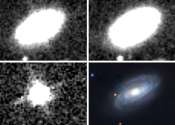Data from NASA's WISE used to preview Lucy mission's asteroid Dinkinesh
NASA's Lucy mission will soon have its first asteroid encounter as the spacecraft travels through deep space en route to Jupiter's orbit. But before the spacecraft passes 265 miles (425 kilometers) from the surface of the ...









